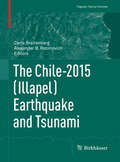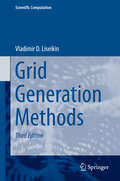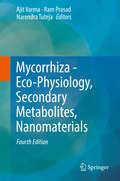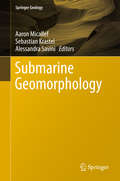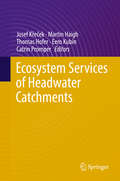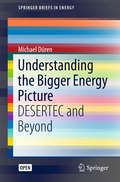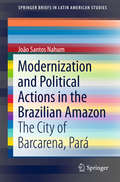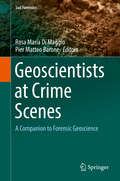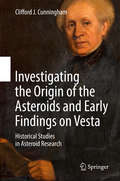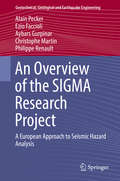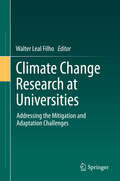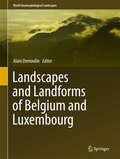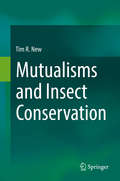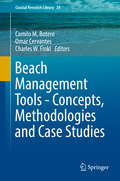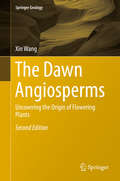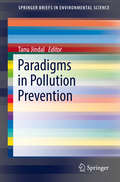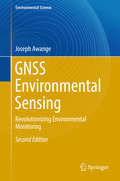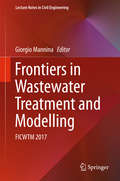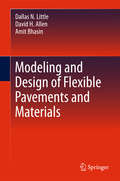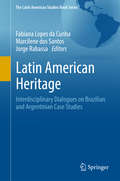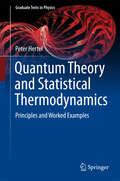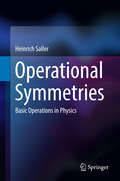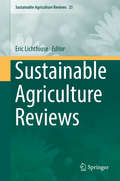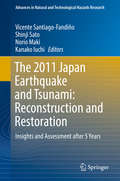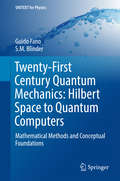- Table View
- List View
The Chile-2015 (Pageoph Topical Volumes)
by Carla Braitenberg Alexander B. RabinovichThis volume presents a collection of contributions that were published in "Pure and Applied Geophysics - pageoph" and which deals with the major earthquake that hit Illapel, Chile on September 16, 2015 with magnitude 8.3, and associated trans-oceanic tsunami. The subducting Nazca plate beneath the Andes caused this major earthquake, generating strong shaking, permanent deformation, free oscillations of the Earth, and tsunamis. This event occurred in the flat-angle subducting segment of the plate.The generated tsunami spread throughout the entire Pacific Ocean and was recorded by numerous coastal tide gauges and open-ocean DART stations.All articles give an up-to-date account of research in one of the most active seismic zones worldwide. An introductory article by Kenji Satake rounds this collection off.
Grid Generation Methods (Scientific Computation)
by Vladimir D. LiseikinThis text is an introduction to methods of grid generation technology in scientific computing. Special attention is given to methods developed by the author for the treatment of singularly-perturbed equations, e.g. in modeling high Reynolds number flows. Functionals of conformality, orthogonality, energy and alignment are discussed.
Mycorrhiza - Eco-Physiology, Secondary Metabolites, Nanomaterials
by Ajit Varma Ram Prasad Narendra TutejaThis is the fourth updated and revised edition of a well-received book that emphasises on fungal diversity, plant productivity and sustainability. It contains new chapters written by leading experts in the field.This book is an up-to-date overview of current progress in mycorrhiza and association with plant productivity and environmental sustainability. The result is a must hands-on guide, ideally suited for agri-biotechnology, soil biology, fungal biology including mycorrhiza and stress management, academia and researchers. The topic of this book is particularly relevant to researchers involved in mycorrhiza, especially to food security and environmental protection.Mycorrhizas are symbioses between fungi and the roots of higher plants. As more than 90% of all known species of plants have the potential to form mycorrhizal associations, the productivity and species composition and the diversity of natural ecosystems are frequently dependent upon the presence and activity of mycorrhizas. The biotechnological application of mycorrhizas is expected to promote the production of food while maintaining ecologically and economically sustainable production systems.
Submarine Geomorphology (Springer Geology)
by Aaron Micallef Sebastian Krastel Alessandra SaviniThis book on the current state of knowledge of submarine geomorphology aims to achieve the goals of the Submarine Geomorphology working group, set up in 2013, by establishing submarine geomorphology as a field of research, disseminating its concepts and techniques among earth scientists and professionals, and encouraging students to develop their skills and knowledge in this field.Editors have invited 30 experts from around the world to contribute chapters to this book, which is divided into 4 sections – (i) Introduction & history, (ii) Data & methods, (ii) Submarine landforms & processes and (iv) Conclusions & future directions. Each chapter provides a review of a topic, establishes the state-of-the-art, identifies the key research questions that need to be addressed, and delineates a strategy on how to achieve this.Submarine geomorphology is a priority for many research institutions, government authorities and industries globally. The book is useful for undergraduate and graduate students, and professionals with limited training in this field.
Ecosystem Services of Headwater Catchments
by Josef Křeček Martin Haigh Thomas Hofer Eero Kubin Catrin PromperThis book addresses the evaluation of environmental impacts and services identified in headwaters of different eco-zones around the world. It presents 24 papers selected from contributions to recent meetings of the European Forestry Commission Working Party on the Management of Mountain Watersheds, which is coordinated by the FAO (Food and Agriculture Organization of the United Nations). Through its biennial sessions and inter-session activities, the Working Party focuses on the continuous exchange of knowledge and experience between professionals in Europe and other regions of the world confronted with similar issues. The contributions have been updated and peer-reviewed, and the interdisciplinary team of authors includes experts from the fields of geography, hydrology, chemistry, biology, forestry, ecology and socio-economics. The participatory management of headwater catchments in Europe, Africa, America and Asia was the central theme of the articles, which were divided into four sessions: (1) Headwater Environment and Natural Resources, (2) Enhancing Environmental Services in Headwaters, (3) Environmental Services in the Changing World, and (4) New Challenges for Environmental Education and Active Citizenship. The practical applications shown in the book address the multi-resource concept. The book offers a unique and valuable resource for environmentalists, engineers, watershed planners and policymakers alike.
Understanding the Bigger Energy Picture: DESERTEC and Beyond (SpringerBriefs in Energy)
by Michael DürenThis book is open access under a CC BY 4.0 license.This book focuses on the global cycles of energy, water and carbon, which are not only the essentials of our main energy carriers, the fossil fuels, but are also the building blocks of life. The book offers an overview of the basic scientific facts and relationships that are needed to understand today’s energy generation and use, how they relate to global climate, the water cycle and other resources, and the complexities of energy policy. Building on the work of the Desertec project, it presents the main technological options that we will have in a world after the “Energiewende” and presents the possible future solutions for a sustainable world. The book is written in an engaging, descriptive style that can be understood by those without specific knowledge of science or economics and allows readers to form their own conclusions. Controversy rages over energy problems, climate change and their possible solutions. Expressions like “climate deniers”, “renaissance of nuclear energy”, “stop the war on coal”, and “Energiewende now” represent a diversity of opinions that divide our society and political leaders. This book shows the reader the whole energy picture and how it is part of the wider global problems of overpopulation and uncontrolled economies in a world of limited resources.
Modernization and Political Actions in the Brazilian Amazon: The City of Barcarena, Pará (SpringerBriefs in Latin American Studies)
by João Santos NahumThis book offers an analysis of the territory of Barcarena, in the Brazilian Amazon. The author studies the land use and the implemented modernization policies that made it one of the richest cities of the state. The political system uses this territory as a resource to provide for the needs of a small circle of social agents. A system of conservative political actions enforces the process of modernization of the Baracena territory. Innovations in the Barcarena territory, such as the implementation of the aluminium factory Albras/Alunorte and the territorial configuration or public administration, lead to modernization simulations and artificial devices. The intended effect however is more about appearing to be modern, than actual modernization. The territorial use of Barcarena is aimed to protect the interests and privileges of the elite.
Geoscientists at Crime Scenes: A Companion to Forensic Geoscience (Soil Forensics)
by Rosa Maria Di Maggio Pier Matteo BaroneThis book presents the forensic geoscience in general and, in particular, in Italy and their application to peculiar crimes. Italy is internationally relevant due to the presence of different kinds of “geo-crimes” (in the first place, environmental mafia), and is emblematic to understanding the best way to fight these crimes. This book will not only offer a new view point to comprehending these “geo-crimes”, but also fresh and updated results of the different methods applied to fight against these crimes. This book is unique in that it is not a collection of articles but an individual work with the same theme beginning with a state-of-the-art of these disciplines to their international value passing through several case studies.
Investigating the Origin of the Asteroids and Early Findings on Vesta: Historical Studies in Asteroid Research
by Clifford J. CunninghamThis book assesses the origin of asteroids by analyzing the discovery of Vesta in 1807. Wilhelm Olbers, who discovered Vesta, suggested that the asteroids were the result of a primordial planet’s explosion. Cunningham studies that idea in detail through the writings of Sir David Brewster in Scotland, the era's most prolific writer about the asteroids. He also examines the link between meteorites and asteroids, revealing a synergy between Ernst Chladni, Romantic symbolism, and the music of the spheres.Vesta was a lightning rod for controversy throughout the nineteenth century with observers arguing over its size and color, and the astounding notion that it was self-luminous. It was also a major force for change, as new methods in the field of celestial mechanics were developed to study the orbital perturbations it is subject to. A large selection of private correspondence and scientific papers complete the first comprehensive historical study of Vesta ever published.With a synoptic look at the four asteroids, Ceres, Pallas, Juno and Vesta, Cunningham provides a valuable resource on asteroid origins and explains how they were integrated into the newly revealed solar system of the early nineteenth century.
An Overview of the SIGMA Research Project: A European Approach to Seismic Hazard Analysis (Geotechnical, Geological and Earthquake Engineering #42)
by Alain Pecker Ezio Faccioli Aybars Gurpinar Christophe Martin Philippe RenaultThis book presents a summary of the important outcomes of the SIGMA project related to all aspects of Probabilistic Seismic Hazard Assessment: source characterization, rock motion characterization, site response characterization, and hazard calculations, with for all of them emphasis on the treatment of uncertainties. In recent years, attempts have been made to identify and quantify uncertainties in seismic hazard estimations for regions with moderate seismicity. These uncertainties, for which no estimation standards exist, create major difficulties and can lead to different interpretations and divergent opinions among experts. To address this matter, an international research project was launched in January 2011, by an industrial consortium composed of French and Italian organizations. This program, named SIGMA (Seismic Ground Motion Assessment) lasted for five years and involved a large number of international institutions.This book is intended for instructors running courses on engineering seismology, graduate students in the same field and practicing engineers involved in Probabilistic Seismic Hazard Analyses.
Climate Change Research at Universities: Addressing the Mitigation and Adaptation Challenges
by Walter Leal FilhoThis unique book provides a multidisciplinary review of current, climate-change research projects at universities around the globe, offering perspectives from all of the natural and social sciences.Numerous universities worldwide pursue state-of-the-art research on climate change, focussing on mitigation of its effects as well as human adaptation to it. However, the 2015 Paris 21st Conference of the Parties of the United Nations Framework Convention on Climate Change (UNFCCC) (COP 21)” demonstrated that there is still much room for improvement in the role played by universities in international negotiations and decision-making on climate change.To date, few scientific meetings have provided multidisciplinary perspectives on climate change in which researchers across the natural and social sciences could come together to exchange research findings and discuss methods relating to climate change mitigation and adaption studies. As a result the published literature has also lacked a broad perspective. This book fills that gap and is of interest to all researchers and policy-makers concerned with global climate change regardless of their area of expertise.
Landscapes and Landforms of Belgium and Luxembourg (World Geomorphological Landscapes)
by Alain DemoulinThis book provides an informative and intriguing overview of the most scenic landscapes of Belgium and Luxembourg. Geodiversity is emphasized, for example the periglacial features in the Hautes Fagnes area, the planation surfaces in the Ardennes and Oesling, and the famous caves of Han/Lesse and Remouchamps. The book’s chief goals are to provide the reader with enjoyable and informative descriptions of the selected sites within their regional geographical and geological settings; to offer an up-to-date survey of the evolution of Belgium’s and Luxembourg’s landscape; and to share additional information on the cultural value of the respective sites wherever appropriate. The book is a richly illustrated reference work that makes accessible for the first time a wealth of information currently scattered among many national and regional journals. It will benefit earth scientists, environmental scientists, tourism geographers and conservationists alike.
Mutualisms and Insect Conservation
by Tim R. NewDocumenting and understanding intricate ecological interactions involving insects is a central need in conservation, and the specialised and specific nature of many such associations is displayed in this book. Their importance is exemplified in a broad global overview of a major category of interactions, mutualisms, in which the interdependence of species is essential for their mutual wellbeing. The subtleties that sustain many mutualistic relationships are still poorly understood by ecologists and conservation managers alike. Examples from many parts of the world and ecological regimes demonstrate the variety of mutualisms between insect taxa, and between insects and plants, in particular, and their significance in planning and undertaking insect conservation – of both individual species and the wider contexts on which they depend. Several taxonomic groups, notably ants, lycaenid butterflies and sucking bugs, help to demonstrate the evolution and flexibility of mutualistic interactions, whilst fundamental processes such as pollination emphasise the central roles of, often, highly specific partnerships. This compilation brings together a wide range of relevant cases and contexts, with implications for practical insect conservation and increasing awareness of the roles of co-adaptations of behaviour and ecology as adjuncts to designing optimal conservation plans. The three major themes deal with the meanings and mechanisms of mutualisms, the classic mutualisms that involve insect partners, and the environmental and conservation lessons that flow from these and have potential to facilitate and improve insect conservation practice. The broader ecological perspective advances the transition from primary focus on single species toward consequently enhancing wider ecological contexts in which insect diversity can thrive.
Beach Management Tools - Concepts, Methodologies and Case Studies (Coastal Research Library #24)
by Camilo M. Botero Omar Cervantes Charles W. FinklThis book provides an overview of beach management tools, including carrying capacity, beach nourishment, environmental and tourism awards (like Blue Flag or others), bathing water quality, zoning, beach typologies, quality index, user's perception, interdisciplinary beach monitoring, coastal legislation, shore protection, social and economic indicators, ecosystem services, and coastal governance (applied in beach case studies). Beaches are one of the most intensely used coastal ecosystems and are responsible for more than half of all global tourism revenues, and as such the book introduces a wide range of state-of-the-art tools that can be used to deal with a variety of beach challenges. Each chapter features specific types of tools that can be applied to advantage in beach management practices. With examples of local and regional case studies from around the globe, this is a valuable resource for anyone involved in beach management.
The Dawn Angiosperms: Uncovering the Origin of Flowering Plants (Springer Geology #121)
by Xin WangThis book discusses the controversial and conflicting hypotheses on the origin of angiosperms, which was generally assumed to be restricted to the Cretaceous and later ages. Since publishing the first edition of “The Dawn of Angiosperms” in 2010, several important advances have been made in this field of science, namely 1) the discovery of new fossil angiosperms from the Jurassic; 2) European researchers discovering angiosperm-like pollen from the Triassic; and most importantly 3) the discovery of a perfect flower from the Jurassic. All of these findings are at odds with the currently widely accepted evolutionary theories, and thus call upon us to critically reassess botanical theory. Accordingly, the new edition of this book not only includes more new fossil taxa, but also documents them in greater detail and corrects many commonly held misconceptions. In so doing, it makes related studies and teaching on the early history of angiosperms more realistic, concrete, and tangible, providing concrete fossil evidence as the basis for future research, and helping to distinguish the most accurate botanical hypotheses.
Paradigms in Pollution Prevention (SpringerBriefs in Environmental Science)
by Tanu JindalFeaturing a collection of informative and descriptive chapters, this book is essential reading for environmental scientists, environmental toxicologists and people from allied fields. The research and its outcomes presented here focus on pollution prevention approaches, clean technologies and toxic use reduction that has the potential for eliminating worker exposure to health risks; and creates healthy and sustainable ecosystems. Readers will discover ways to incorporate prevention in the design of industrial processes that help to eliminate harmful environmental effects while promoting the competitiveness of industries. Issues such as biological control agents for sustainable urban agriculture, safe water and soil health; waste management and utilization in food processing industries, and ranking of Benzene, Toluene, Ethylbenzene and Xylene (BTEX) with respect to ozone formation are addressed in this book. Particular attention is given to interrelated issues associated with global warming and the use of genetically engineered organisms (GEM's) for combating pollution in extreme environments. The authors invite researchers to think through the critical analysis presented here and recommend future pathways for further research.
GNSS Environmental Sensing: Revolutionizing Environmental Monitoring (Environmental Science and Engineering)
by Joseph AwangeThis book is the second edition of Environmental Monitoring using GNSS and highlights the latest developments in global navigation satellite systems (GNSS). It features a completely new title and additional chapters that present emerging challenges to environmental monitoring—“climate variability/change and food insecurity.” Since the publication of the first edition, much has changed in both the development and applications of GNSS, a satellite microwave remote sensing technique. It is the first tool to span all four dimensions of relevance to humans (position, navigation, timing and the environment), and it has widely been used for positioning (both by military and civilians), navigation and timing. Its increasing use is leading to a new era of remote sensing that is now revolutionizing the art of monitoring our environment in ways never imagined before.On the one hand, nearly all GNSS satellites (Global Positioning System (GPS), Global Navigation Satellite System (GLONASS), Galileo and Beidou) have become operational, thereby providing high-precision, continuous, all-weather and near real- time remote sensing multi-signals beneficial to environmental monitoring. On the other hand, the emerging challenges of precisely monitoring climate change and the demand for the production of sufficient food for ever-increasing populations are pushing traditional monitoring methods to their limits.In this regard, refracted GNSS signals (i.e., occulted GNSS signals or GNSS meteorology) are now emerging as sensors of climate variability, while the reflected signals (GNSS reflectometry or GNSS-R) are increasingly finding applications in determining, e.g., soil moisture content, ice and snow thickness, ocean heights, and wind speed and direction, among others. Furthermore, the increasing recognition and application of GNSS-supported unmanned aircraft vehicles (UAV)/drones in agriculture (e.g., through the determination of water holding capacity of soil) highlights the new challenges facing GNSS.As such, this new edition three new chapters address GNSS reflectometry and applications; GNSS sensing of climate variability; and the applications in UAV/drones. Moreover, it explores the application of GNSS to support integrated coastal zone management.
Frontiers in Wastewater Treatment and Modelling: FICWTM 2017 (Lecture Notes in Civil Engineering #4)
by Giorgio ManninaThis book describes the latest research advances, innovations, and applications in the field of water management and environmental engineering as presented by leading researchers, engineers, life scientists and practitioners from around the world at the Frontiers International Conference on Wastewater Treatment (FICWTM), held in Palermo, Italy in May 2017. The topics covered are highly diverse and include the physical processes of mixing and dispersion, biological developments and mathematical modeling, such as computational fluid dynamics in wastewater, MBBR and hybrid systems, membrane bioreactors, anaerobic digestion, reduction of greenhouse gases from wastewater treatment plants, and energy optimization. The contributions amply demonstrate that the application of cost-effective technologies for waste treatment and control is urgently needed so as to implement appropriate regulatory measures that ensure pollution prevention and remediation, safeguard public health, and preserve the environment. The contributions were selected by means of a rigorous peer-review process and highlight many exciting ideas that will spur novel research directions and foster multidisciplinary collaboration among different water specialists.
Modeling and Design of Flexible Pavements and Materials
by Dallas N. Little David H. Allen Amit BhasinThis textbook lays out the state of the art for modeling of asphalt concrete as the major structural component of flexible pavements. The text adopts a pedagogy in which a scientific approach, based on materials science and continuum mechanics, predicts the performance of any configuration of flexible roadways subjected to cyclic loadings. The authors incorporate state-of the-art computational mechanics to predict the evolution of material properties, stresses and strains, and roadway deterioration. Designed specifically for both students and practitioners, the book presents fundamentally complex concepts in a clear and concise way that aids the roadway design community to assimilate the tools for designing sustainable roadways using both traditional and innovative technologies.
Latin American Heritage: Interdisciplinary Dialogues on Brazilian and Argentinian Case Studies (The Latin American Studies Book Series)
by Fabiana Lopes da Cunha Marcilene Dos Santos Jorge RabassaFocusing on Brazil, this book approaches the term “heritage” from not only a historical and architectural point of view, but also considers its artistic, archaeological, natural, ethnological and industrial aspects. The book is divided into four thematic sections – 1) traditions and intangible heritage, 2) archaeological heritage, 3) natural heritage and landscapes, and 4) heritage of industrial and built environments – and presents chapters on a diverse range of topics, from samba and cultural identities in Rio de Janeiro, to the history of Brazilian archaeology, the value of scenic landscapes in Brazil, and the cultural landscape of Brazil.As an outcome of the First Heritage International Symposium, this unique book explores a variety of heritage dialogues, pursuing global and specific approaches, and combining different views, perceptions and senses.
Quantum Theory and Statistical Thermodynamics: Principles and Worked Examples (Graduate Texts in Physics)
by Peter HertelThis textbook presents a concise yet detailed introduction to quantum physics. Concise, because it condenses the essentials to a few principles. Detailed, because these few principles – necessarily rather abstract – are illustrated by several telling examples. A fairly complete overview of the conventional quantum mechanics curriculum is the primary focus, but the huge field of statistical thermodynamics is covered as well.The text explains why a few key discoveries shattered the prevailing broadly accepted classical view of physics. First, matter appears to consist of particles which, when propagating, resemble waves. Consequently, some observable properties cannot be measured simultaneously with arbitrary precision. Second, events with single particles are not determined, but are more or less probable. The essence of this is that the observable properties of a physical system are to be represented by non-commuting mathematical objects instead of real numbers. Chapters on exceptionally simple, but highly instructive examples illustrate this abstract formulation of quantum physics. The simplest atoms, ions, and molecules are explained, describing their interaction with electromagnetic radiation as well as the scattering of particles. A short introduction to many particle physics with an outlook on quantum fields follows. There is a chapter on maximally mixed states of very large systems, that is statistical thermodynamics. The following chapter on the linear response to perturbations provides a link to the material equations of continuum physics. Mathematical details which would hinder the flow of the main text have been deferred to an appendix.The book addresses university students of physics and related fields. It will attract graduate students and professionals in particular who wish to systematize or refresh their knowledge of quantum physics when studying specialized texts on solid state and materials physics, advanced optics, and other modern fields.
Operational Symmetries: Basic Operations in Physics
by Heinrich SallerThis book describes the endeavour to relate the particle spectrum with representations of operational electroweak spacetime, in analogy to the atomic spectrum as characterizing representations of hyperbolic space. The spectrum of hyperbolic position space explains the properties of the nonrelativistic atoms; the spectrum of electroweak spacetime is hoped to explain those of the basic interactions and elementary particles. In this book, the theory of operational symmetries is developed from the numbers, from Plato’s and Kepler’s symmetries over the simple Lie groups to their applications in nonrelativistic, special relativistic and general relativistic quantum theories with the atomic spectrum for hyperbolic position and, in first attempts, the particle spectrum for electroweak spacetime. The standard model of elementary particles and interactions is characterized by a symmetry group. In general, as initiated by Weyl and stressed by Heisenberg, quantum theory can be built as a theory of operation groups and their unitary representations. In such a framework, time, position and spacetime is modeled by equivalence classes of symmetry groups. For a unification on this road, the quest is not for a final theory with a basic equation for basic particles, but for the basic operation group and its representations.
Sustainable Agriculture Reviews: Volume 18 (Sustainable Agriculture Reviews #25)
by Eric LichtfouseThis book deals with a rapidly growing field aiming at producing food and energy in a sustainable way for humans and their children. It is a discipline that addresses current issues: climate change, increasing food and fuel prices, poor-nation starvation, rich-nation obesity, water pollution, soil erosion, fertility loss, pest control and biodiversity depletion. This series gathers review articles that analyze current agricultural issues and knowledge, then proposes alternative solutions.
The 2011 Japan Earthquake and Tsunami: Insights and Assessment after 5 Years (Advances in Natural and Technological Hazards Research #47)
by Vicente Santiago-Fandiño Shinji Sato Norio Maki Kanako IuchiThis book covers the restoration and reconstruction process and activities undertaken in Japan in the first five years since the 2011 Earthquake and Tsunami – a period widely considered to be the most intensive reconstruction phase within the 10-year restoration plan drawn up by the Japanese Government. The respective chapters explore technical, scientific, social and non-scientific (policy-related) aspects, including: reconstruction and restoration policies, infrastructure and designs for tsunami coastal defence, resilient urban areas and affected communities, housing and relocation schemes, disaster mitigation and evacuation measures, reactivation of the economy, revitalization of fisheries and coastal agriculture, and industry and tourism. The book also illustrates some of the achievements and failures in a broad range of projects and initiatives intended to address the above-mentioned issues, making it particularly relevant for experts, decision makers, students and other interested scholars.
Twenty-First Century Quantum Mechanics: Mathematical Methods and Conceptual Foundations (UNITEXT for Physics)
by Guido Fano S M BlinderThis book is designed to make accessible to nonspecialists the still evolving concepts of quantum mechanics and the terminology in which these are expressed. The opening chapters summarize elementary concepts of twentieth century quantum mechanics and describe the mathematical methods employed in the field, with clear explanation of, for example, Hilbert space, complex variables, complex vector spaces and Dirac notation, and the Heisenberg uncertainty principle. After detailed discussion of the Schrödinger equation, subsequent chapters focus on isotropic vectors, used to construct spinors, and on conceptual problems associated with measurement, superposition, and decoherence in quantum systems. Here, due attention is paid to Bell’s inequality and the possible existence of hidden variables. Finally, progression toward quantum computation is examined in detail: if quantum computers can be made practicable, enormous enhancements in computing power, artificial intelligence, and secure communication will result. This book will be of interest to a wide readership seeking to understand modern quantum mechanics and its potential applications.
